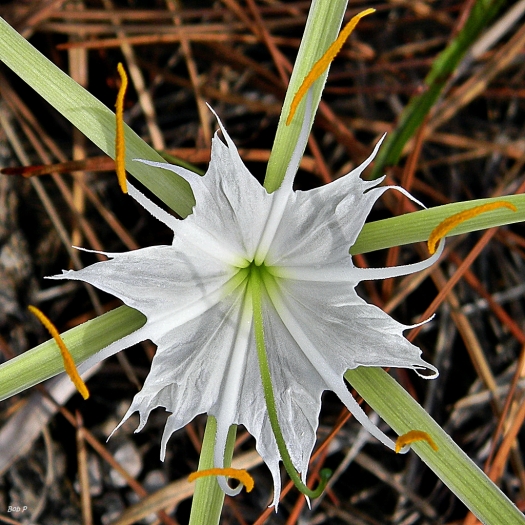Alligatorlily
(Hymenocallis palmeri)
Alligatorlily (Hymenocallis palmeri)
/
/

Bob Peterson
CC BY-SA 2.0
Image By:
Bob Peterson
Recorded By:
Copyright:
CC BY-SA 2.0
Copyright Notice:
Photo by: Bob Peterson | License Type: CC BY-SA 2.0 | License URL: https://creativecommons.org/licenses/by-sa/2.0 | Uploader: File Upload Bot (Magnus Manske) | Publisher: Wikimedia Commons | Title: Alligator_Lily_(Hymenocallis_palmeri)_(8248700633).jpg | Notes: ;Scientific name: Hypericum patulum *{{ja|キンシバイ}} Place:Hyogo-ken Japan {{Information| |Description = Hypericum patulum |Source = KENPEI's photo |Date = 2006-06-01 |Author = KENPEI |Permission =GFDL,Creative Common























Estimated Native Range
Summary
Hymenocallis palmeri, commonly known as Alligatorlily, is a semi-deciduous perennial herb native to wetlands, marshes, and the edges of ponds and streams in the southeastern United States, particularly in Florida. It typically grows from egg-shaped bulbs up to 4 cm across. The leaves of the Alligatorlily are bluish-green, strap-like, and can reach up to 65 cm in length and 10 mm in width. Its flowers are particularly showy, with erect, funnel-shaped, white petals and a distinctive greenish eye at the center. The margins of the staminal corona are adorned with teeth-like projections, adding to its ornamental appeal. The flowering season occurs in the summer, and the blooms are known for their fragrance and attractiveness to pollinators.
Alligatorlily is valued for its striking flowers and is often used in water gardens, rain gardens, and as a pond marginal plant. It requires consistently moist or even wet soil conditions and can thrive in full sun to part shade environments. While it is relatively low maintenance, it is important to ensure that the soil does not dry out. Due to its habitat preferences, Alligatorlily is not drought-tolerant and may not be suitable for xeriscaping. In regions where conditions mimic its native habitat, it can naturalize and spread, though it is not typically considered invasive.CC BY-SA 4.0
Alligatorlily is valued for its striking flowers and is often used in water gardens, rain gardens, and as a pond marginal plant. It requires consistently moist or even wet soil conditions and can thrive in full sun to part shade environments. While it is relatively low maintenance, it is important to ensure that the soil does not dry out. Due to its habitat preferences, Alligatorlily is not drought-tolerant and may not be suitable for xeriscaping. In regions where conditions mimic its native habitat, it can naturalize and spread, though it is not typically considered invasive.CC BY-SA 4.0
Plant Description
- Plant Type: Herb
- Height: 1-1.5 feet
- Width: 1-1.5 feet
- Growth Rate: Moderate
- Flower Color: White
- Flowering Season: Spring, Summer, Fall
- Leaf Retention: Semi-Deciduous
Growth Requirements
- Sun: Full Sun, Part Shade
- Water: High
- Drainage: Slow
Common Uses
Bee Garden, Bird Garden, Butterfly Garden, Fragrant, Hummingbird Garden, Low Maintenance, Showy Flowers
Natural Habitat
Wetlands, marshes, and the edges of ponds and streams in the southeastern United States, particularly in Florida
Other Names
Common Names:
Scientific Names: , Hymenocallis palmeri, Hymenocallis humilis,
GBIF Accepted Name: Hymenocallis palmeri S.Watson